A People-Following Mobile Robot Using Kinect and a Laser Scanner- Juniper Publishers
Juniper Publishers- Journal of Robotics
Abstract
This research proposes a people-following mobile
robot system that is equipped with Kinect RGB-D camera and a laser
scanner, in which the Kinect’s skeleton tracking function helps,
identify people in the depth image. First, the system selects a person
who raises his two hands as the target to follow. Second, the system
identifies the target to follow from the person’s location and color
characteristics of clothes. When an occlusion occurs, the system uses
the information from the laser scanner to guide the motion of the mobile
robot and tries to re-recognize the target to follow at the same time.
The people-following mobile robot accomplishes a human detection and
follows only the target even if more than two people are located around
the target person. The research conducts several experiments and shows
the effectiveness of the proposed system to identify and follow a human
in an indoor environment.
Keywords: Mobile robot; People-following; Kinect camera; Laser scanner; Human skeleton detection; Gesture recognition
Introduction
The ability to detect human motion, gestures, and behavior is an important task for service robots [1].
A robot that can carry luggage and follow a customer can be very
helpful in many situations. Such a service robot should be able to
interact with people and co-exist with people in a crowded environment
designed basically for humans. Equipped with cameras, a robot can obtain
images of the environment where it is situated through visual sensors
and with the ability of visual perception can recognize objects and
determine their locations. However, using only a 2D image is very
difficult to identify or track the target in a 3D world. Kinect is a
RGB-D camera combining a RGB image and a 3D depth image that can
recognize the movement of a human. Kinect can extract the 3D positions
of a human body’s joints, which can then be further processed to
recognize human gestures. Kinect has been applied in various application
fields such as health care, sport training, gaming, security, 3D
construction, human motion recognition and many others. For instance,
Kinect technology has been found to be very useful in various healthcare
related services, such as physical therapy exercises, sport
rehabilitation games, motor skill training, monitoring patient
activities, medical operation room assistance, and other clinical areas [2].
Kinect (Kinect for Windows SDK V2.0) is able to track
the skeletons of multiple persons by using only their depth image, and
so it can be very easy to create gesture-driven applications [3].
Kinect can track at most 25 joint points of a human body skeleton and
up to 6 persons at the same time. With the availability of tracking a
human body’s skeleton joints positions and orientations for each user,
the task of feature extract becomes much easier. One only needs to
determine which joints are the most important for each activity.
Gesture recognition can be broadly categorized into
gesture detection, pose estimation and gesture classification. Hand
gesture detection is even a critical factor in sign language
understanding. Because a hand is a smaller part in the human body, so
detection and classification of hand gestures may be even more complex.
In general, to develop a useful Kinect application involving human
motion recognition, the following steps are typically required:
o Real-time human skeleton tracking;
o Recognition of the semantics of the activity or gesture formed by the motion; and
o Actions triggered by the detection of the particular motion.
There are many more reports of useful applications of
Kinect in mobile robot systems. A Kinect based people- following mobile
robot system was designed with its mission to keep the person in the
centre of depth images and in at a fixed distance away from the mobile
robot [4]. An autonomous robot equipped with 3 Kinects was built to follow and track a person [5].
The system selected a person who raised a hand as the target to follow
at the beginning. The system could then identify a person from the
person's location and characteristics of clothes and re-recognize the
target to follow when an occlusion occurred. A Kinect was installed in a
mobile frame at a height of around 120cm [6].
The system utilized color, depth, and skeleton frames from Kinect to
find and track people for basic robotic movements like wander around and
follow- me. Kinect was found useful in building an indoor map. For
instances, Kinect and a laser range finder were used together to acquire
environmental 2D map information [7]. In addition, 3D point cloud data from Kinect were transformed into an enhanced 2.5D and then down to a 2D grid map [8].
For the first step toward an autonomous service
robot, we study a people-following mobile robot system, which is
equipped with Kinect RGB-D camera and a laser scanner. Kinect is used to
track human skeletons and to identify people from the depth image. The
system selects a person who raises his two hands as the target to follow
at the beginning. The system then identifies the target to follow from
the person's location and RGB color characteristics of clothes. In the
case of target occlusion, the system switches over to use the
information from a laser scanner to plan the robot motion [9].
The robot is a two-wheel differential driven mobile robot controlled by
a FPGA controller operating in a closed-loop speed PI control with a
built-in encoder odometer to record its pose (position and orientation).
System Overview
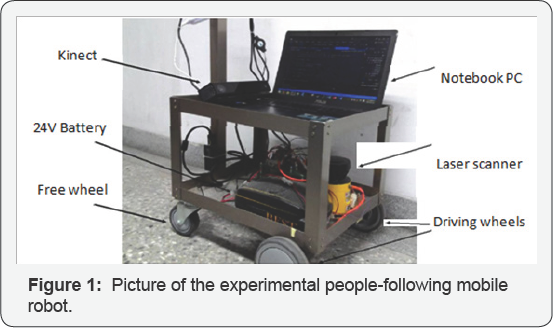
The experimental people-following mobile robot system as shown in Figure 1
includes mainly a differential-drive mobile robot platform, a Kinect
camera V2, a laser scanner SICK 200, a notebook computer, and a 24V
lithium polymer battery. The mobile robot platform consists of two
independent driving wheels and two free wheels. The actuator of the
driving wheel is the dc motor with gear and encoder, which is in
velocity PI control. The radius of driving wheel is r=75mm, and the
distance of two driving wheels is 2L, where L=20mm. The wheel is
actuated by a dc motor (motor maximum no-load speed 3000rpm) with a 17:1
gear reducer, and the motor encoder has a resolution of 68,650ppc. The
motor speed control system is built on an Altera DE0-nano FPGA
development board running at a system clock rate of 50Mhz. Motor speed
PI control and series communication modules are implemented using
Verilog HDL and synthesized by an Altera Quartus II EDA tool. The Kinect
camera processing and connected curve generation programs are
programmed in Visual C++ for PC.
Define to be the position of the middle of the two
wheels in the world frame {W}. The origin of the robot base frame {B} is
assigned to the middle of the two driving wheels, and is the yaw angle
of the x-axis of the robot frame with respect to the x-axis of the world
reference frame, as shown in Figure 2. Thus, is the pose (position and orientation) of the mobile robot in the world coordinate frame Figure 2.
Coordinate frames of the mobile robot system: the world frame {W}, the
robot base frame {B} with origin at the middle of the two driving
wheels, and the Kinect coordinate frame {K}.
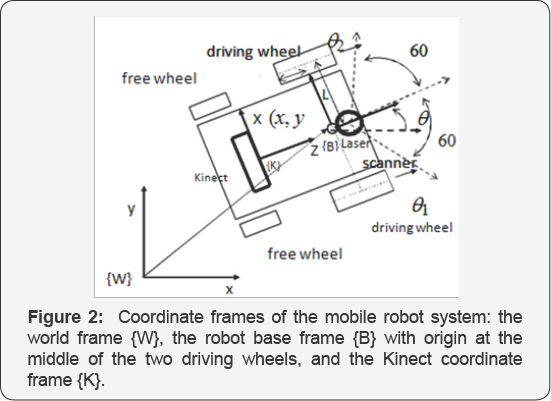
A Kinect V2 camera is installed at the upper middle
of the free wheels of the mobile robot. The Kinect has two cameras, the
left one is the RGB camera to obtain color images, and the middle one is
the IR depth camera. The RGB color image has a resolution of 1920x1080
at 30 frames per second. The IR depth (D) image is 16-bit (in mm) at a
resolution of 512x424, and the sensor range is between 0.5m and 8.0m at
30 frames per second. The depth of each pixels is computed based on the
phase shift of the emitted modulated light and corresponding reflected
light. The Kinect coordinate system {K} is centered on the Kinect's IR
sensor as shown in Figure 2,
in which the Y-axis points upward, the Z-axis points where the Kinect
is pointing, and the X-axis is to the left (or cross-product of Y-axis
and Z-axis). In this work, the Kinect is used mainly for human motion
tracking and recognition as well as target person detection.
A laser scanner, SICK S200, is installed at the front
end of the robot platform. Its main function here is to avoid obstacles
such as doors, walls, and people. The principle of a laser scanner is
based on time- of-flight. It can scan a range of 270 degrees in a
resolution of 0.5 degrees and returns 16-bit distance values between
1.0cm and 800cm. For practical reasons, only 120 degrees of a scanned
range are used here as shown in Figure 2. The laser range data’s updating time is 0.5 seconds.
Figure 3
shows the overall system block diagram of the people-following mobile
robot control system. The system's operation is according to two
external sensors (Kinect & laser scanner) and internal sensors
(motor encoders). When the Kinect system is successful at detecting and
tracking the target person, the mobile robot follows his steps;
otherwise, the mobile robot is guided by the laser scanner to avoid
local obstacles and tries to return to the state of tracking the target
person. The mobile robot's pose trajectory history is recorded from
motor encoder odometry.

Target person recognition and detection
Human motion tracking and recognition
One of the most important Kinect features is body
tracking, as the Kinect can track a total of 25 skeletal joints per
person. With Kinect for Windows SDK V2.0 one can extract the 3D
positions of a human body's joints, which can then be further processed
to recognize human gestures. In this work, we used the data of a body
skeleton: joint rotations, positions and angles between joints for
tracking and recognition of the target person to follow. The system only
selects the person who raises his two hands as the target to follow.
Here, we build a Kinect application system using only a single depth
image to supports the following human motion tracking and recognition
tasks:
Step 1: Record the sequence of hand-raising gestures (Figure 4) by using Kinect Visual Gesture Builder in Kinect Studio, which is used to identify the target to follow.
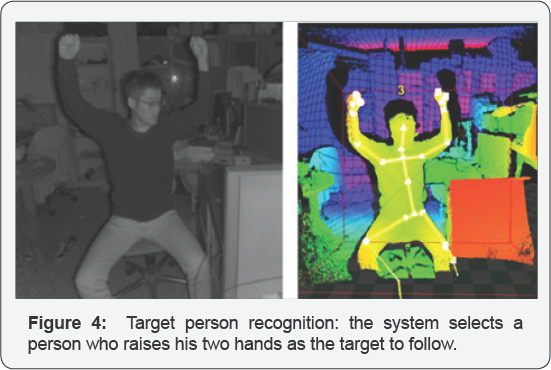
Step 2: Track human body skeletons up to 6 persons (called body frames) at the same time.
Step 3: Compare body gestures with the recorded
target sequence and return a confidence value between 0 and 1. A
confidence value of 0.95 indicates that a target person is successfully
identified. A RGB model image is saved for target person detection
later.
Target person detection

Target person detection is based on a comparison of
color characteristics of his clothes in a body ROI (Region-of-interest)
as shown in Figure 5.
The body ROI of size 250x250 is formed from 4 human body joints in a
detected human skeleton: spine base, shoulder right, shoulder left and
spine shoulder. First, the RGB image, 0 ≤ R,G,B ≤ 255 , is transformed to the HSV image, 0 ≤ H ≤ 180 , 0 ≤ S ≤ 255 , and 0 ≤ V ≤ 255 . To compare two histograms, the histogram I from the input image and the histogram M of the model image, a metric of intersection d (I, M) is used to express how well both histogram match, whereby

When, d(I,M) ≥ 0.25 , it
indicates that the target person is detected successfully. In summary,
the program flowchart of human motion detection and target person
detection is shown in Figure 6.

People Following Motion Planning
Mobile robot motion planning by tracking target person
Let v and ω be the
instantaneous linear velocity command of the origin and angular velocity
command of the robot base frame, respectively. Let (xc, xc, zc) be the detected neck joint point of the target person in the Kinect coordinate frame {K}. Define  to be the angle of the target person with respect to the robot base frame. The mobile robot motion command ( v and ω ) is planned according to target tracking position (xc,xc,zc) . The linear velocity command v is a nonlinear function consisting of linear segments, dead-zones and saturations as below,
to be the angle of the target person with respect to the robot base frame. The mobile robot motion command ( v and ω ) is planned according to target tracking position (xc,xc,zc) . The linear velocity command v is a nonlinear function consisting of linear segments, dead-zones and saturations as below,
 to be the angle of the target person with respect to the robot base frame. The mobile robot motion command ( v and ω ) is planned according to target tracking position (xc,xc,zc) . The linear velocity command v is a nonlinear function consisting of linear segments, dead-zones and saturations as below,
to be the angle of the target person with respect to the robot base frame. The mobile robot motion command ( v and ω ) is planned according to target tracking position (xc,xc,zc) . The linear velocity command v is a nonlinear function consisting of linear segments, dead-zones and saturations as below,
Where, parameters zmax = 300 cm, zmln = 150 cm, z1 = 30 cm, z0 = 45 cm, vmax = 27.5 cm/sec, and vmln = 20.6 cm/sec. Similarly, the angular velocity command ω is planned as below,

Mobile robot motion planning by laser scanner
The above target tracking planning strategy will fail
whenever the vision system fails to update the new location of the
target person. In such a case, the laser scanner is used to resolve the
difficult situation. The range data s (in cm) of the laser range scanner in a range of 120 degrees as shown in Figure 2 are rewritten as

Where, α = 0.5 (j — 271) degrees, 151 ≤ j ≤ 391 and safety threshold smln = 70 cm. The value of n(α) = 1 denotes that the line of sight at an angle of α relative to the x-axis of the robot's base frame is free of any obstacle; otherwise, n(α) = 0 denotes that there is an obstacle in this direction angle. Let θ*
be the previous target tracking angle (relative to the x-axis of the
world frame) just before a failed detection of a new target object
occurs, and θ is the current mobile robot's orientation angle.
The mobile robot now plans to move forward, if n(α) = 1 , for -45° <α< 45° , and cos(θ-θ')>
0 ; otherwise, the robot rotates in place counter clockwise (or
clockwise) if there is more free range in the left-side than the
right-side (or the right- side than the left side). The above procedure
is repeated until the target object is verified and detected again. Figure 7
shows the program flowchart of guidance by a laser scanner. Because the
robot always maintains a minimum safety distance of 70 cm in its front
end and its only mission is to follow the target person, it therefore
seldom needs to consider the problem of obstacle avoidance when the
target object is in front of it.

Experimental Results
During the experiments, the maximum robot's speed is
set to 25.5cm/sec and the target's proximity distance to 30 cm for the
safety reason. In the first people-following experiment, there are two
persons around the target person. First, a person raises his two hands
to be assigned as the target to follow. The mobile robot then identifies
and tracks the target to follow from the target person's location and
color characteristics of his clothes. The people-following mobile robot
accomplishes a human detection and follows only the target of following
even if more than two people are located around the target person. Figure 8
shows multi-shots of the first people-following mobile robot
experiment. Multi-shots of the first people-following mobile robot
experiment; the target person identification is performed right before t
= 0 sec.; and tracking the target person starts right after.
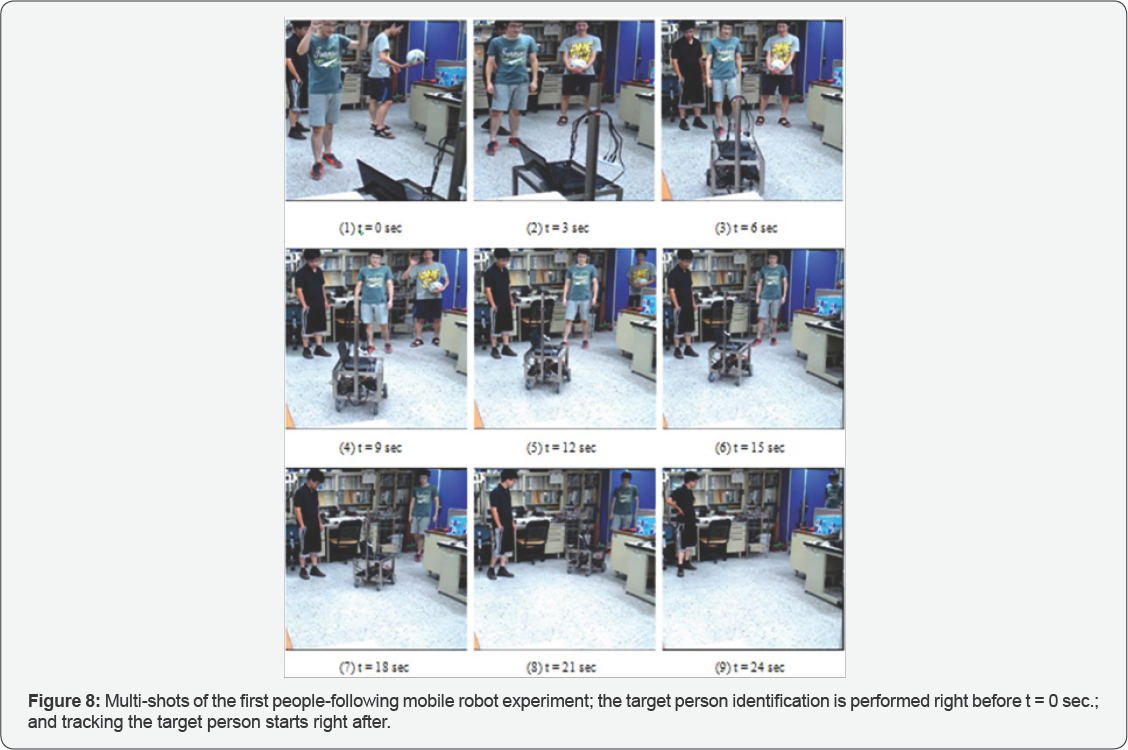
In the second people-following mobile robot
experiment, there is one person walking through the space between the
mobile robot and the target person during the experiment. The mobile
robot accomplishes the target person identification and detection and
successfully follows only the target person even if a person is walking
across between the mobile robot and the target person. Figure 9
shows multi-shots of the second mobile robot experiment. At time t =
21sec. a person appears in the front of the robot and an occlusion
occurs, the system re-recognizes the target person after the breaking
person who appeared walks away from the robot.


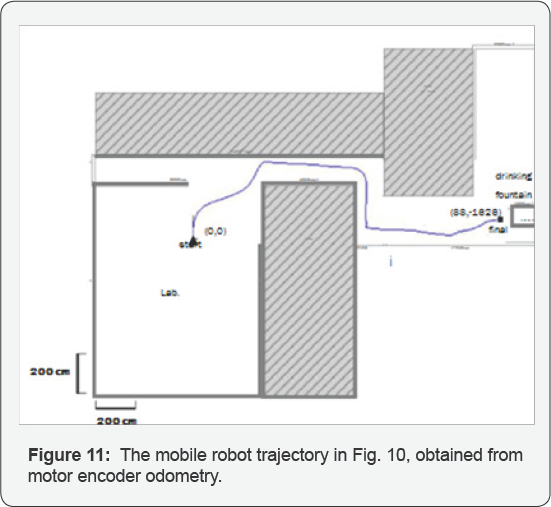
In the third example, the mobile robot accomplishes
the task of following the target person to walk through a hallway and
through doors inside an office building. Figure 10,11
show multi-shots and the mobile robot trajectory of the third
people-following experiment, respectively. Whenever the target person
walks inside a door, an occlusion easily occurs. The system always
re-recognizes the target person after the robot passes through the door
by using the information from the laser scanner. In summary, the
experimental robot system recognizes the target to follow successfully
on more than 95% of the trials and the target person recognition time is
less than 0.1 seconds.
Conclusion
This paper has proposed a people-following mobile
robot system based on a Kinect sensor and a laser scanner. The robot is
able to follow a target person if that person is identified through
Kinect. When the target person disappears, the robot uses the range
information obtained from a laser scanner to plan its motion and to
re-recognizes the target person at the same time. The experimental
results show that the people-following mobile robot accomplishes the
task of tracking only the target person to follow even if more than two
people are located around the target person or the mobile robot.
Furthermore, the mobile robot also accomplishes the task of following
the target person to walk through a hallway and through doors inside an
office building. In our experiments, the experimental robot system
recognizes the target to follow successfully on more than 95% of the
trials and the target person recognition time is less than 0.1 seconds.
The main advantage of the proposed approach is that the system combines a
Kinect camera and a laser scanner so that the system can look around
the space and re-cognize the target when a target person is out of the
sensing region of Kinect.
Acknowledgement
This work is supported by a grant from Taiwan's Ministry of Science and Technology, MOST 106-2221-E-011-151.
For more open access journals please visit: Juniper publishers
For more articles please click on: Robotics & Automation Engineering Journal


Comments
Post a Comment